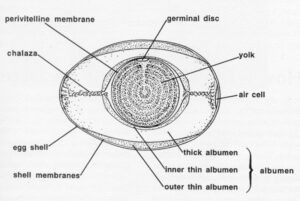CHAPTER-8 EGG COOKERY

INTRODUCTION TO EGG COOKERY
Eggs contain most nutrients and are low in calories 90 calories per egg.Egg protein is complete & easily digestible,therefore it is useful to balanced meals.Eggs are useful as main dish as they are protective food,provide energy & nutrients for growth & repair of our body.
DEFINITION
The round or oval reproductive body laid by the female of many animals,containing the developing embryo and its food reserves protected by a shell or skin.
Eggs are one of the kitchens most important items. From mayonnaise to meringues, soups to sauces,appetizers to desserts they are prominent on any menu.
The ability to select the right egg for a particular dish(shell eggs, yolks only whites only or pasteurized eggs) is critical to the success of any dish that includes eggs as an ingredient. According to culinary lore the Chef’s hat with its many pleats represents the many ways that a chef can prepare eggs.Eggs can be served at virtually any meal as part of every course. They can be cooked in the shell, poached or fried or scrambled and can be prepared as omelletes, souffles -they add colour and flavour to other dishes.
Although the eggs of many birds ,fish and even reptiles can be used as food the word at an qualified applies exclusively to hens egg .All other types of egg offered for sale must be labeled appropriately –quail’s egg, duck’s egg etc. There are also exotic varieties such as crocodile or ostrich eggs.
EGG,EGG WHITE & EGG YOLK
The average weight of hens egg is 60 gram (2 oz). The shell weigh about 12% of the total weight of the “egg “ and is made of calcareous porous substance which is pervious to air,water and smells. It is lined with the delicate pellucid membrane which separates itself from the shell at the larger end of the egg to form the air chamber. The size of this chamber is an inverse proportion to the freshness of the egg- the fresher the egg , smaller the chamber.
The albumin or the white of the egg is thick viscous, transparent liquid containing half the protein content of the egg. It also has a high percentage of water and some mineral substances. Albumin is soluble in cold water and congeals at 70 degree centigrade or 158 Fahrenheit and remains from then on insoluble. It forms about 55% of the total weight of egg .
Yolk of the egg is 30% of the total weight.It is an obaque substance which congeals in heat. The Yolk is composed of albumin, fat containing vitamins, lecithins, nucliens, chlorestins and mineral substances including a a ferruginous pigment called haematogen., which gives it its colour. It contains germs( visible in fertilized egg -this does not mean the egg is inedible). The remaining protein and all the fats especially lecithin , together with iron ,sulphur and vitamins ABDE.
Eggs are nourishing and perfectly balanced food fairly low in calories they supply all the amino acids essential, for human nutrition and are easy to digest provided they are not made up into rich dishes However,those on a low animal fat diet should restrict their consumption of egg yolks.
As written above,the egg is composed of two main parts the white and yolk ,various membranes help keep the yolk suspended at the centre of the white and help prevent contamination or weight loss through evaporation.
B. STRUCTURE OF AN EGG

C. SELECTION OF EGG
- The egg shell should be cleaned well shaped long and slightly rough.
- When eggs are broken there should be a high proportion of thick white to thin white. If an egg is kept the thick white gradually changes into their white and water passes from the White into the Yolk.
- Yolk should be firm, round (not flattened) and of a good even colour. As eggs are kept the Yolk loses strength and begins to flatten, water evaporates from the egg and is replaced by air.
- Eggs in the Shell should be free from cracks, leaking and obvious wholes.
- All eggs in the Shell should be free from cracks ,leaking and obvious holes
HOW TO CHECK FRESHNESS OF EGGS ?
- A fresh egg is heavy and should feel well filled. And and loses a tiny fraction of water through the porous shell.
It is easy to test the freshness of an egg by plunging it into salted water
- An egg up to three days old will fall at once to the bottom.
- An egg 3 to 6 days old will float Halfway up the water.
- If it is bad it floats horizontally on top of the water.
- Another method is to break the egg into a plate.
- If the Yolk is compact and positioned in the centre of the egg is fresh.
- If the egg is 1 week old the Yolk is not in the centre.
- In the at that is 2-3 weeks old the Yog has a tendency to spread.
- The freshness of an egg can also be tested by holding it up to light a very small air chamber indicates a very fresh egg.
POINTS TO BE NOTED
- Fresh eggs should be used within a month and stored and washed with the pointed and down in the least cold part of the refrigerator.
- The egg and the egg shell are permeable to Smells.
- Hard- boiled egg will keep for four days unshelled two days, if shelled.
- Hard- boiled egg pickle in flavored vinegar and sterilized will keep for months.
- A raw egg yolk will keep for 24 hours.
- A raw egg white will keep for 6 to 12 hours.
- Dessert containing raw eggs should be eaten within 24 hours.
- Fresh eggs can be frozen if they are broken into a bowl and poured into suitable containers.
EGGS & DISEASES
Raw egg yolks are a potentially hazardous food due to the possible presence of salmonella bacteria Salmonella bacteria are killed when the egg are held at a temperature of at least 60 degree centigrade for for minimum of three and half minutes the bacteria is also killed instantly at 71 degrees fried egg poached eggs should be served only at customer request.
Any food containing eggs must be kept at safe temperature thora Li handling and cooking and storage cooking and eating must be done quicklyThe ability to select the right egg for a particular dish (shell egg,yolks only,whites only or pasteurized eggs
D. USES OF EGG IN COOKERY

Whole eggs as well as whites and yolks separately play important culinary roles.
Whole eggs are used as the main component of many breakfast dishes and can be prepared by scrambling, frying.poaching, in custard ,in baked goods. Whole eggs are used as a glaze and to add nourishment, flavour and colour.
The egg white consists almost exclusively of water and protein called albumin .Its ability to form a relatively stable foam is crucial to the development of proper structure in many items like Angel food cake soufflés, meringues. Egg whites are key ingredients in clarifying stocks and broths to produce the Consommes. They may also replace some or all of other binders used in some food specially moussellines made from fish poultry or vegetable.
The Yolk contains protein,significant amount of fat and a natural emulsifier lecithin. The yolk has ability to foam also. This function plus its ability to form emulsions make egg yolk crucial to the preparation of such items as mayonnaise, hollandaise sauce and genoise sponge cakes. Yolks are also responsible for providing additional richness to food,as when they are included liaison in sauces or soups.
Eggs are nutritious, inexpensive and probably the most versatile ingredient in cooking.They are of prime importance in many branches of Food Industry especially those concerned with pasta, ices, biscuit and cakes.
In kitchen they have innumerable uses,they serve as:
- Binding agent
- Coating agent
- Leavening agent
- Emulsification
- Glazing- Enhances Colour and Sheen
- In force meats
- Enriches and enhances flavour and taste
- Thickening agent
- Decoration and garnishing of dishes
10.Clarifying agent
EGG PREPARATIONS
- Eggs a la coque-Boiled Eggs
- Eggs En Cocotte-Eggs cooked in individual dishes in a bain marie in the oven.
- Eggs Sur le Plat-Shirred eggs-Eggs cooked in a pan or in individual dishes in a cool oven.
- Fried Eggs-Sunny side up or down
- Hard Boiled Eggs
- Omelletes -Plain,Stuffed
- Poached Eggs
- Scrambled Eggs
- Soft Boiled Eggs etc.
PROPER STORAGE TIME & TEMPERATURE
Egg whole in shell 5 to 7 days 33 -38 F /1-3 C
Eggs whole Fluids 2 to 3 days 29-32 F/ -1 to 0 C
Eggs frozen 1 to 2 months -10to 0F/-23 to -18 C
Eggs Dried 1- 2 months 40 fF/4 C
